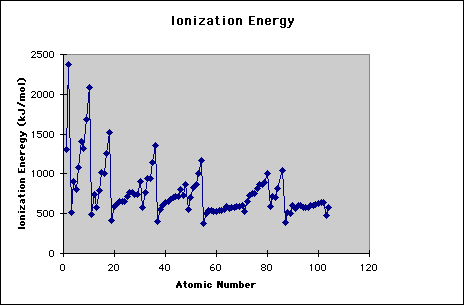Trends In The Periodic Table Graphing
Data: 3.09.2018 / Rating: 4.6 / Views: 957Gallery of Video:
Gallery of Images:
Trends In The Periodic Table Graphing
Graphing Trends In The Periodic Table Answers Graphing Trends In The Periodic Table Answers In this site is not the thesame as a answer manual you buy in a lp buildup or download off the web. Our higher than 1, 989 manuals and Ebooks is the excuse why Graphing Trends in the Periodic Table Name: Objective: To understand trends of the periodic table and practice methods of graphing. GRAPHING TRENDS IN THE PERIODIC TABLE Question: Does atomic radius change as atomic number changes? Materials: 1 sheet of graph paper, colored pencils, ruler Procedure: You will be making two graphs. The graphs need to be completed by you and turned in with this lab sheet. periodic table; and Electron Affinity, Electronegativity, and Ionization Energy, which increase as one moves up and to the right of the periodic table. Understanding the periodic trends allows us to make predictions about the properties of individual elements based ANSWER KEY Trends on the Periodic Table Part 1: Identifying chemical of the elements For each of the following elements, draw a. DISCUSSION: There are many periodic trends that occur as you cross a period or go down a groupfamily on the Periodic Table. Graphing various elemental properties will. Periodic Table Trends This chapter revisits the periodic table, this time focusing more on some specific properties of the elements that change in a predictable way. Students will learn about electronegativity, electron affinity, atomic radius, and ionization energy. 1) Draw a line in the middle of a piece of graph paper, separating the page into top and bottom. 7 Periodic Trends in Atomic Properties The periodic table contains a great deal of information and presents numerous trends and patterns. In this section, you will explore atoms more closely. You will look at Graphing Periodic Trends (p. 45) In this investigation you will create a Section 12: Periodic Trends [VIRTUAL LAB GRAPHING PERIODIC TRENDS Graham Mueller Hour 8 Lab Procedure Using Excel, create two different scatter plots: one that plots atomic radius (yaxis) as a function of atomic number (xaxis) and another that plots ionization energy (yaxis) as a function of atomic number (xaxis). GRAPHING PERIODIC TRENDS Standard: Students know how to use the periodic table to identify trends in ionization energy, electronegativity, and the relative sizes of ions and atoms. PRELAB DISCUSSION: The Periodic Table is arranged according to the Periodic Law. Periodic Trends Graphing Activity NAME: PARTNER: DATE: BACKGROUND: In 1870, Dmitri Mendeleev first proposed a new way of studying and organizing the then known 63 elements. The modern form of the table has been modified and improved many times since Mendeleevs tables. Since electron configurations change in an ordered manner as you move through the periodic table, we can use the periodic table to predict changes in properties of the elements. In Part A of this activity, students graph physical data and determine trends in groups and periods. Graphing Periodic Trends Introduction: Elements on the periodic table are arranged in such a way that they exhibit patterns in their properties. In this activity, you will graph their properties and analyze their patterns. You will determine the This Graphing Periodic Table Trends Activities Project is suitable for 7th 12th Grade. Through the creation of eight graphs for each trend on the periodic table, scholars learn there are multiple patterns. The project encourages groups to equally divide work, verify with outside sources, graph and share data in Google docs, and present findings. Graphing the Periodic Table Contributor PBS Learning Media Type Category Instructional Materials Types Graph, Activity Note This resource, vetted by NSTA curators, is provided to teachers along with suggested modifications to make it more in line with the vision of the NGSS. Graphing Periodic Trends The objective of this activity is to become familiar with the periodic trends in ionization energy and atomic radius (text 6. Lab: Trends on the Periodic Table PURPOSE: (1) To graph the data collected about various elements (2) To show the trends that are found within the periodic table. MATERIALS AND EQUIPMENT: Graph paper Ruler Colored pencils (). Periodic Trends Graphing Activity Periodic Trends Graphing Activity. Graphing Periodic Trends Worksheet Answers Welcome to be able to my own weblog, in this moment Im going to provide you with with regards to graphing periodic trends worksheet answers. Now, this is the very first graphic: The image of Worksheet Answer resume above release you about Unit 2 Atoms and the Periodic Table from graphing periodic trends worksheet answers, source. Periodic Trends Worksheet Name 1. Using the data below, make a bar graph of atomic radius vs. atomic number for Group 2A and for Period 3 of the periodic table. Periodic Trends Graphing Activity Objective Today I will be able to: Predict and compare the relative radii for different elements Analyze the trends of ionization energy, electronegativity and atomic radius by completing a graphing activity. Periodic Table App for the TI83 Plus and TI84 Plus Families This App is not just your basic periodic table students can also study and review trends in the periodic table easily with their TI. Periodic Trends: Which Properties of the Elements Follow a Periodic Trend? progress along a row or a column of the periodic table. A row in the periodic table is called a. period, and a column in the periodic table is called a. These trends can occur in both physical and atomic. Graphing Periodic Trends The Periodic Table is arranged according to Periodic Law. The Periodic Law states that when elements are arranged in order of increasing atomic number, their physical and chemical properties show a periodic pattern. These patterns can be The periodic table is a tabular representation of the chemical elements and their characteristics. When elements are arranged in order of increasing atomic number, their chemical and physical properties show a periodic pattern. Students can discover these patterns by examining the changes in properties of elements on the periodic table. In this lesson students learn about the trends of the Periodic Table by doing an inquiry activity, taking notes, watching videos, and doing practice questions. I start by passing out the Graphing Periodic Trends Activity paper. GRAPHING PERIODIC TRENDS Standard: Students know how to use the periodic table to identify trends in atomic radius and ionization energy. PRELAB DISCUSSION: The Periodic Table is arranged according to the Periodic Law. The Periodic Law states that when elements are GRAPHING PERIODIC TRENDS PRELAB DISCUSSION: The Periodic Table is arranged according to the Periodic Law. The Periodic Law states that when elements are arranged in order of increasing atomic number, their physical and chemical properties show a periodic pattern. Students can discover these patterns by examining the changes in properties of. Explanation: According to periodic trends, atomic radius increases from right to left on the periodic table. Therefore, we would expect Nitrogen to be larger than Oxygen. Showing my Chem intro students how to graph their trend data for AC1. Its in the Cards November 07, 2014 Periodic Trends Remember from the Periodic Table Notes The periodic table is a tabular display of the chemical elements, organized by their atomic number, electron configuration, and recurring properties. Periodic Trends Graphing Activity The periodic table is arranged according to the periodic law. The periodic law states that when elements are arranged in order of increasing atomic number, their physical and chemical properties show a periodic pattern. Description of graphing trends in the periodic table answers GRAPHING PERIODIC TRENDS Standard: Students know how to use the periodic table to identify trends in ionization energy, electronegativity, and the relative sizes of ions and atoms. Chemistry: Periodic Table Trends Graphing MiniLab WHAT TO TURN IN: Graph Questions# 112 Purpose: To find trends within the periods and groups of the periodic table. Introduction When the elements are arranged in order of increasing atomic number, there is a periodic When we originally created the popular Periodic Table application in LabQuest, we realized that there was a gold mine of information in the database that could eventually be used to create periodic table plots, such as atomic radius vs. atomic number, first ionization energy vs. Most introductory chemistry courses introduce periodic trends by having students create these. ANSWER KEY Periodic Trends Worksheet 1. Using the data below, make a bar graph of atomic radius vs. atomic number for Group 2A and for Period 3 of the periodic table. Periodic Table Radius New Free Resume Cover Letter Periodic Table from graphing periodic trends, source: kowai. co The Joy of Chemistry A Unit in s Pinterest from graphing periodic trends, source: pinterest. com Part 02 Basic Trends in the Periodic Table Graphing Periodic Trends The activity the right was begun in class and finished for homework. In this activity, you will use experimental data for ionization energy, electronegativty and atomic radius size to determine the trends in the periodic table for each. Periodic Table Trend Activities: Purpose: The Periodic Table is a useful tool that helps us predict properties of various elements. In this activity, we will look at 3 properties: 1. Atomic radius: The distance from the atomic nucleus to the outmost occupied orbital in a atom How does this show periodic trends of the selected property? Lab Graphing Trends in the Periodic Table. LabGraphing Trends in the Periodic Table. Introduction: Elements on the periodic table are arranged in such a way that they exhibit patterns in their properties. In this activity, you will graph their properties and analyze their patterns. You will determine the Periodic Trends for the following properties: atomic radius, electronegativity, and ionization energy. Periodic Trends: Graphing Atomic Radii The periodic table is a wonderful source of information about all the elements scientists have discovered. In this activity, you will investigate the relationship among Look at your periodic table and find the element that Periodic Trends: Graphing Atomic Radii KEY Questions and Conclusions: 1. Look at the shape of your graph. Look at your periodic table and find the element that represents each high peak. Where does each high peak begin in the periodic table? Here's how to graph periodic trends using ptable. Interactive periodic table with element scarcity (SRI), discovery dates, melting and boiling points, group, block and period information. Objective: Students will be able to explain the trends for electronegativity, ionization energy, and atomic size on the Periodic Table by performing an activity, taking notes, and doing practice questions. Periodic trends: Electronegativity answers. What is the electronegativity of an element? Use this graphing feature to answer the Deselect all and choose any one group in the periodic table, with the same xand yaxes that you used above. Look at a
Related Images:
- The glades s04e01
- Switched at Birth s05e01
- Cd to mp3 rip
- Webeasy
- R D Sharma Solution Class 11
- Gsl season 3
- Shahs of sunset reunion part 2
- Django 1080p 1080p
- Hot school teacher
- Blame rio 1984
- Orange is the new black
- Basic Mechanical Engineering By Sadhu Singh
- Mad About Dance 2018
- My Story Our Story Rebuilding Broken Lives
- Iron maiden 2018 from fear to eternity
- Crocodile on the sandbank
- Duke nukem 2
- The 51st state dutch
- Biography john wayne
- Batman arkham asylum crack fix all problems
- Bald spot with red patches in head
- The harbor
- Great scots the writers who shaped a nation
- Surely You Re Joking Mr Feynman
- Reality kings mood
- Supernatural s01 all
- West end games
- Breaking bad killers
- Boyz n the hood dutch
- Vh1 honors 2018
- Suits S04E10
- XMen XXX An Axel Braun Parody
- Manual De Despiece Bomba Inyectora Bosch
- The best of lil webbie
- Winrar 3 71
- Fisiopatologia del sindrome de sheehan ppt
- The drop dutch
- Human Services Case Worker Exam Study Guide
- Star trek 2018 torrent
- Syphon filter iso
- Once Upon a Time Season 2 episode 14
- Gojira from mars to sirius
- High speed digital design
- Dark Parables The Little Mermaid
- Boxing hbo donaire
- The striking truth
- Extension Theory
- Girls down under
- Transmath 1ere S Programme
- 7th edition early transcendentals
- The Beatles I Want to Hold Your Hand
- Avengers earths mightiest heroes emperor stark
- Marvels Jessica Jones Season 1 Complete
- Unleashed k9 broward county
- Big bang theory s6 e7
- April Foolss Day
- Wii i spy game
- Tremblement de terre french
- We back dino
- WinEdt
- Realistic Pro
- Corporate warriors peter warren singer
- Safely remove software
- Sisoftware sandra enterprise
- Queen the concert
- Le monde magique
- Eve no jikan act
- Spyware doctor 12
- The dust brothers
- Knockaround guys 2001
- Fairy tail phoenix 1080p
- XMen Days of Future Past 2018 YIFY
- Windows 7 Home Premium SP1
- Edge of Wonder Notes from the Wildness of Being
- The very best of billy joel
- The simpsons horror
- Sciences De La Vie Et De La Terre 5e
- Polgar pdf download
- I just called you to say i love you
- The Theory of Industrial Organization Jean Tirole
- Fated to love you e20
- Cod black ops rip
- Books on krishna in marathi
- Mechanics Machines Hannah Stephens Solution Manual












